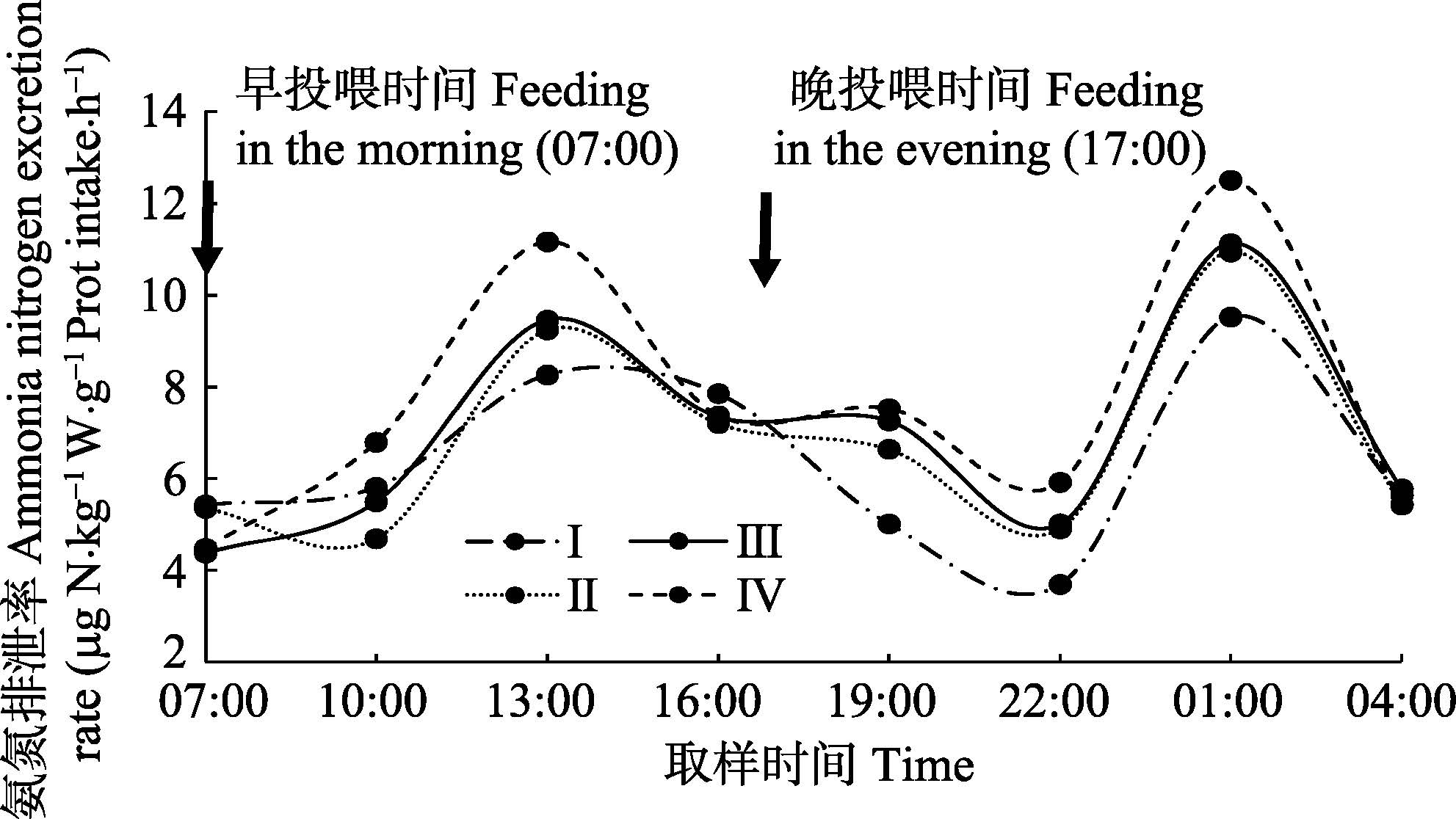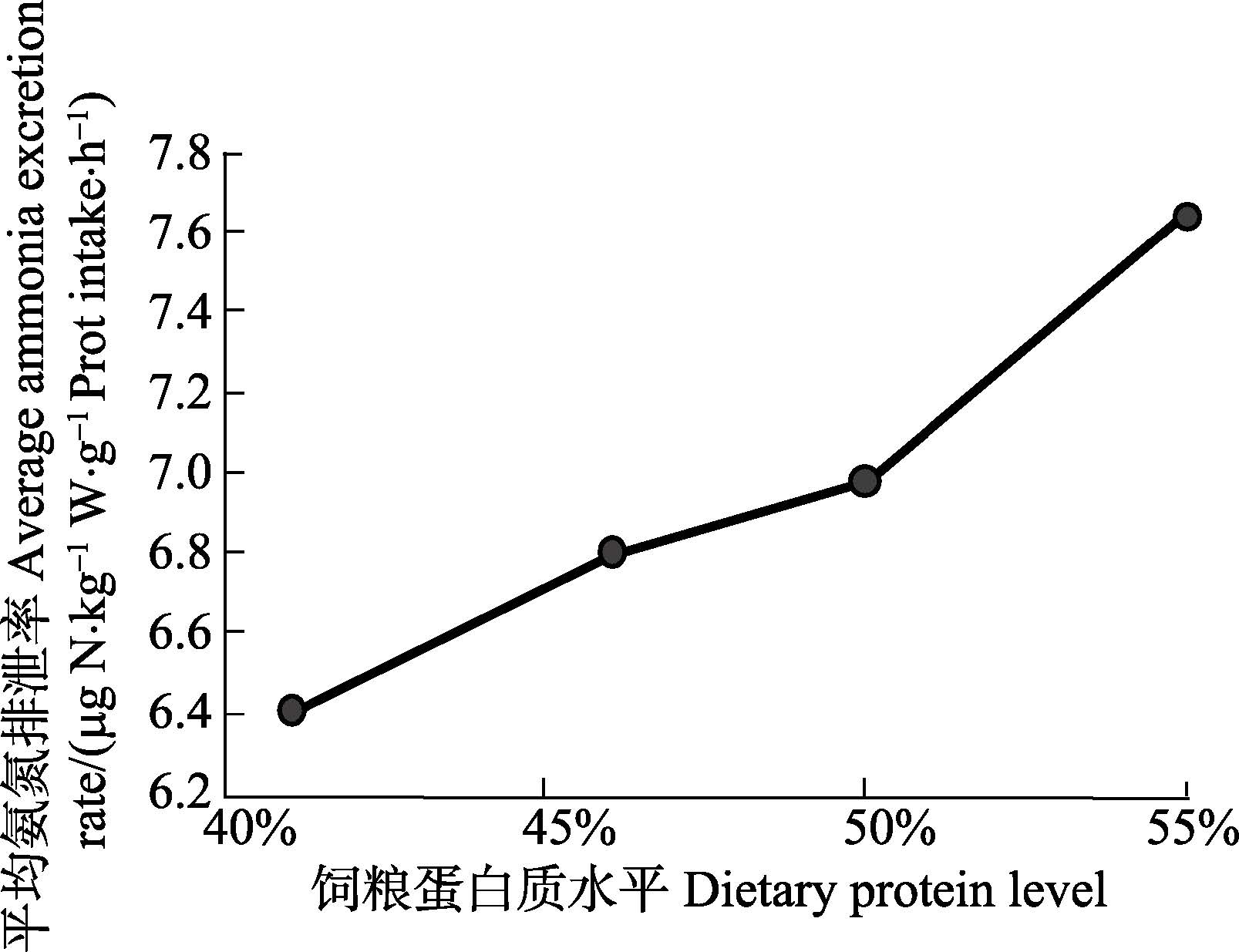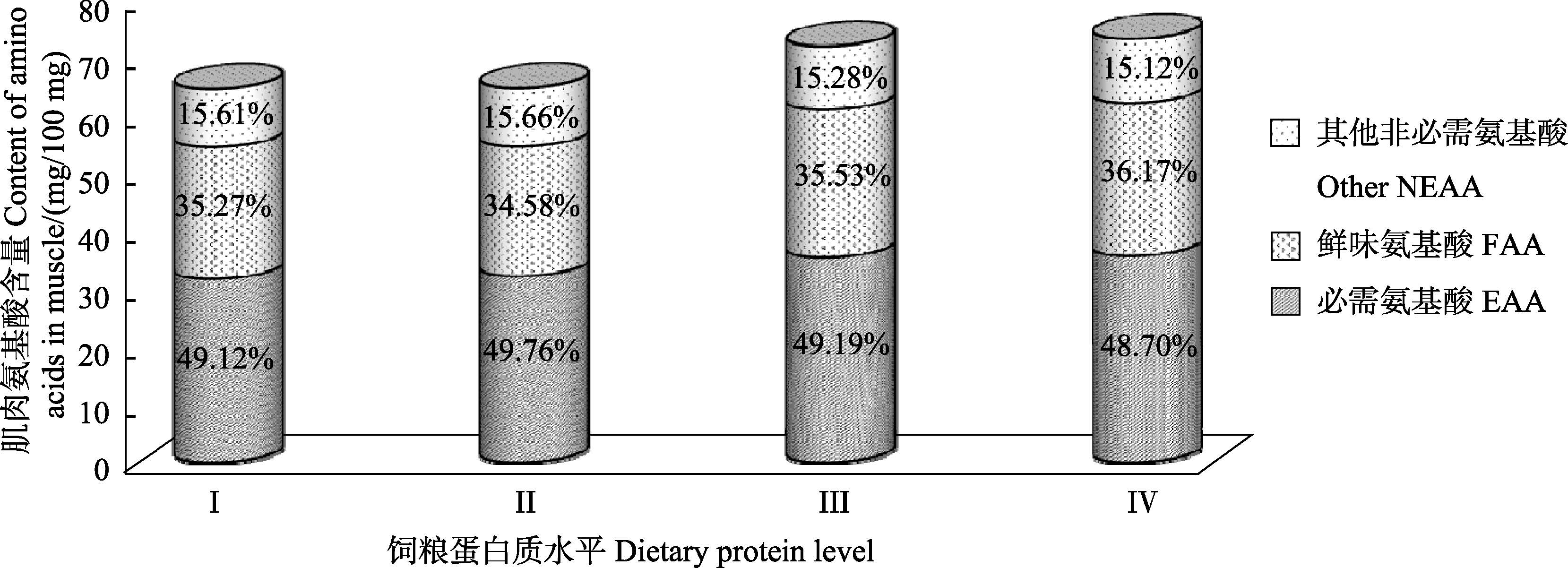2. 中国科学院大学 北京 100049
2. University of Chinese Academy of Sciences, Beijing 100049
蛋白质是鱼虾必需的核心营养物质,直接影响其生长、繁育、代谢和健康,但同时也是鱼虾氮排泄及养殖水体自污染的主要因素(Mathis et al,2003; Burford et al,2004; 蒋克勇等,2005)。在工业化循环水养殖模式下,水体中氨氮及有害菌是养殖过程中监控的关键因素。高浓度氨氮会造成养殖水体溶氧降低、水质恶化、病菌滋生,影响正常养殖。因而,蛋白质作为影响氨氮排泄的主要因素,值得深入研究。
研究表明,饲粮蛋白水平在适当范围内升高能有效提高鱼类消化功能和饲料利用率,促进生长(蒋克勇等,2005; 李爱杰等,2001; 陈四清等,2004; 马俊等,2016; 李勇等,2004; 梅琳等,2015; Gonzalez-Rodriguez et al,2014);蛋白质摄入与鱼类血氨浓度、蛋白积累、氨氮排泄及尿素氮排泄之间的关系也在一些硬骨鱼类实验中得以发现(严俊丽等,2016; Kaushik,1980; Jobling,1981; Kikuchi et al,1991; Dosdat et al,1995a、b),但关于饲粮蛋白营养变化影响工业养殖鱼类生长、氨氮排泄及肌肉氨基酸积累的研究比较少或其效应不够明晰,而对大菱鲆(Scophthatmus maximus L.)该方面研究更为鲜见。
在本课题组对海水鱼饲粮蛋白营养影响养殖水生态研究(蒋克勇等,2005; 李勇等,2004; 李勇等,2010a、b)的基础上,本研究在工业化循环水养殖模式下,探寻饲粮蛋白含量变化对大菱鲆生长、氨氮排泄以及肌肉氨基酸积累的影响特征和规律,为工业化海水鱼养殖的生态营养调控提供科学依据。
1 材料与方法 1.1 实验设计和管理实验开始前对实验鱼禁食24 h,选择大小均匀[(145.08±0.56)g]、健康、活力好的大菱鲆幼鱼,随机分配于12个85 cm × 55 cm × 45 cm养殖箱中,每箱12尾,饲喂4种不同蛋白营养水平的饲粮(秘鲁鱼粉为唯一变量,蛋白水平分别为41%、46%、50%和55%,以Ⅰ、Ⅱ、Ⅲ和Ⅳ组表示),每种饲粮设3个重复。
实验在室内封闭循环水系统中进行,日换水10%,每天45个循环,驯养10 d,正式实验64 d,实验水温为(15.5± 0.5)℃,溶氧9-10 mg/L,盐度22±1,水深(40±2)cm,光周期L:D=11:13,实验饲粮配方见表 1。每天投喂2次(07:00和17:00)至饱食,每次投喂0.5 h后,将残饵虹吸,记录剩余饲料颗粒数,并乘以平均粒重,从投饲量中扣除。发现死鱼及时捞出称重,记录。实验结束前,饥饿24 h,次日称重。
|
|
表 1 大菱鲆实验饲粮组成及主要营养成分含量 Table 1 Ingredients and composition of experimental diets for turbot(%) |
| $增重率\left( \% \right) = \frac{{平均末重 - 平均初重}}{平均初重} \times 100$ |
| $特定生长率\left( {\% /{\rm{d}}} \right){\rm{ = }}\frac{{\ln 平均末重 - \ln 平均初重}}{实验天数} \times 100$ |
| $饲料系数 = \frac{摄食量}{{平均末重 - 平均初重}}$ |
氨氮排泄测定采用24 h连续监测的方法,每隔3 h取样1次,每个处理3个重复,每个重复分别取等量入水和出水。测定期间正常投喂,以07:00为起点取样(喂前取样),具体时间点为07:00、10:00、13:00、16:00、19:00、22:00、01:00和04:00。总氨氮(Total ammonia nitrogen,TAN)测定采用纳氏试剂法。
1.3.2 排泄率计算氨氮排泄率根据下列公式推导:
| $Q{{C}_{i}}dt+\alpha dt=Q{{C}_{k}}dt+Vd{{C}_{k}}\Rightarrow \left( {{C}_{i}}-{{C}_{k}}+\frac{\alpha }{Q} \right)dt=\frac{Q}{V}d{{C}_{k}}$ |
取样间隔为3 h
| $\begin{align} & \int_{t}^{t+3}{\frac{d\left( {{C}_{i}}+\frac{\alpha }{Q}-{{C}_{k}} \right)}{{{C}_{i}}+\frac{\alpha }{Q}-{{C}_{k}}}}=\int_{t}^{t+3}{-\frac{Q}{V}dt}\Rightarrow \\ & \ \ \ \ \alpha =\frac{Q}{1-{{e}^{-\frac{Qt}{V}}}}\left[ {{C}_{k+3}}-{{C}_{i+3}}-({{C}_{k}}-{{C}_{i}}){{e}^{-\frac{Qt}{V}}} \right] \\ \end{align}$ |
将公式细化
| $\Rightarrow \alpha =\frac{Q}{1-{{e}^{-\frac{Qt}{V}}}}\left[ {{C}_{k+3}}-{{C}_{i+3}}-({{C}_{k}}-{{C}_{i}}){{e}^{-\frac{Qt}{V}}} \right]\times \frac{1}{BP}$ |
式中,α为氨氮排泄率(mg∙kg-1鱼重∙g-1蛋白质摄入∙h-1);Q为流速(L/h);t为2次取样时间间隔(此处为3 h);V为养殖水体体积 (L);Ck、Ck+3为前后2次取样时出水口水氨氮浓度(mg/L);Ci、Ci+3为前后 2次取样时入水口水氨氮浓度(mg/L);B为鱼体总重(kg);P为蛋白质摄入量(g)=饲料摄入量×饲料粗蛋白含量。此公式根据Dosdat等(1995a)中的公式结合循环水系统特点进行优化,将蛋白质摄入量加入其中,整个公式推导过程适合循环水养殖模式。
1.4 鱼体肌肉氨基酸组成测定 1.4.1 肌肉样品采集及前处理每个重复取6条体重相近的实验鱼,冰盘处死,在鱼体两面沿脊椎剥下等量无刺肉片,去除鱼皮,用绞肉机反复搅碎,混合均匀,60℃烘干至恒重,干燥皿中冷却至室温后粉碎过40目筛。
1.4.2 测定方法取0.1 g左右处理好的样品,每处理3个重复,按照国标GB/T 18654.10-2008——养殖鱼类种质检验第10部分:“肌肉营养成分的测定”中的方法用氨基酸自动分析仪测定。
1.5 统计分析实验数据用SPSS 16.0统计软件进行单因素方差分析(One-way ANOVA),当差异显著时(P<0.05),进行Duncan’s多重比较。实验结果以平均值±标准差(Mean±SD)表示。
2 结果 2.1 生长性能如表 2所示,实验鱼增重率随饲粮蛋白水平升高而提高,其中,Ⅲ、Ⅳ两组增重率分别极显著高于Ⅰ组61.25%和65.95%(P<0.01),分别显著高于Ⅱ组18.48%和21.93%(P<0.05),Ⅲ、Ⅳ两组间无显著差异;饲料系数则相反,Ⅲ、Ⅳ两组分别极显著低于Ⅰ组25.64%和28.21%(P<0.01),Ⅱ、Ⅲ、Ⅳ三组间没有显著差异。
|
|
表 2 饲粮蛋白水平对实验鱼生长性能的影响 Table 2 Effects of the dietary protein level on the growth performance of juvenile turbot |
结合表 3单因素方差分析结果和图 1变化特征可知,大菱鲆氨氮排泄率呈现明显节律性,即摄食后排泄率逐渐升高,至6(早)-8(晚)h达排泄高峰,后逐渐降低,以此周期性循环。此外,大菱鲆氨氮排泄率与饲粮蛋白水平呈正相关,早投喂3 h后,Ⅳ组排泄率显著高于Ⅱ组44.78%(P<0.05);摄食6 h后,各组排泄率达到峰值,此时Ⅳ组排泄率极显著高于其他3组35.07%、20.76%及17.95%(P<0.01),Ⅲ组排泄率显著高于Ⅰ组14.51%(P<0.05);晚投喂后2 h,后3组排泄率极显著高于Ⅰ组(P<0.01),至投喂后8 h,各组排泄率达第二次高峰,此时Ⅳ组排泄率极显著高于Ⅰ组31.27%(P<0.01),显著高于Ⅱ组14.25%(P<0.05),与Ⅲ组差异不显著;待至投喂后11 h,各处理组实验鱼排泄率已无显著差异,直至次日投喂前。将各处理组大菱鲆24 h平均氨氮排泄率对饲粮蛋白水平作图,由图 2可见,随饲粮蛋白含量增加,大菱鲆氨氮排泄率呈先缓增后趋于平稳趋势,饲粮蛋白含量超过50%时,实验鱼氨氮排泄率急剧增加。
|
|
表 3 饲粮蛋白水平对实验鱼24 h氨氮排泄率的影响 Table 3 Effects of the dietary protein level on the ammonia excretion rate of juvenile turbot during 24 h continuous monitoring(μg N∙kg-1 Weight∙g-1 Protein intake∙h-1) |

|
图 1 饲粮蛋白水平对实验鱼24 h氨氮排泄率变化特征的影响 Figure 1 The change features of ammonia excretion rate with dietary protein levels day and night(24 h) |

|
图 2 饲粮蛋白水平对实验鱼氨氮排泄率的影响 Figure 2 Effects of the dietary protein level on the ammonia excretion rate of juvenile turbot |
如表 4所示,可检测出的17种常见氨基酸,在各处理组鱼肌肉内含量丰富,总量均高于65 mg/100 mg,且随饲粮蛋白质水平的升高呈逐渐增加趋势,其中,Ⅲ、Ⅳ组无论在肌肉总氨基酸(TAA)、必需氨基酸(EAA),还是鲜味氨基酸(Flavor amino acid,FAA)含量,均略高于Ⅰ、Ⅱ组,而Ⅲ、Ⅳ两组间差别较小,但4组间各项指标差异并不显著(P>0.05)。
|
|
表 4 饲粮蛋白质水平对实验鱼肌肉氨基酸组成与含量的影响 Table 4 Effects of different dietary protein level on the amino acid composition and contents in turbotxs muscle(mg/100 mg) |
图 3比较直观地显示了不同处理组大菱鲆肌肉中EAA、FAA和其他NEAA占TAA的百分比。由图 3可见,在氨基酸组成比例方面不存在如含量一般的规律性,说明饲粮蛋白水平并不能对肌肉氨基酸构成比例产生显著影响。

|
图 3 饲粮蛋白质水平对实验鱼肌肉氨基酸含量及比例的影响 Figure 3 Contents and proportions of turbotxs muscle amino acids in different treatments 图中百分比为各组分占TAA的比例 Percentages in the figure were proportions that accounted for TAA |
本课题组前期对海水鲽形目鱼的研究发现,实验鱼增重率随饲粮蛋白含量增加呈先升高后趋缓的趋势(李勇等,2010a; Li et al,2011)。本研究结果中,随饲粮蛋白含量由41%增至50%,实验鱼的增重率和饲料系数均得到显著改善,而55%组较50%组实验鱼在生长性能指标上并无显著变化,此结果与本课题组前期研究结果完全一致。
饲粮蛋白含量直接影响鱼类氨氮排泄率,这点已在多种养殖鱼类研究中得以证实(Lee Gallagher et al,1987; Kaushik et al,1991; Ballestrazzi et al,1994; Chakraborty et al,1998)。本课题组在近年开展了工业化循环水养殖模式下鲆鲽目鱼类的研究,如对半滑舌鳎(Cynoglossus semilaevis)(李勇等,2010a)、大菱鲆(Li et al,2011)等生态营养需要量的研究。本研究在以往研究的基础上,进一步考证饲粮鱼粉蛋白营养变化对大菱鲆氨氮排泄的影响。结果显示,实验鱼氨氮排泄率与饲粮蛋白含量关系密切,即随饲粮蛋白含量的增加呈先升高后趋稳趋势,而在蛋白含量超过50%后,氨氮排泄率急剧升高,基本符合前期重要研究结果“菱形特征”(Li et al,2011)。由此证实,在工业化循环水养殖条件下,饲粮蛋白含量超过50%时,大菱鲆幼鱼氨氮排泄对水环境污染程度显著加大,而其增重率的提高并不显著,不利于可持续健康养殖模式的建立。故该生长阶段饲粮适宜粗蛋白含量为45%-50%。
3.2 饲粮蛋白水平对大菱鲆幼鱼氨氮昼夜排泄特征的影响鱼类对食物的消化吸收导致其排氨量上升,常在进食后4-10 h出现排泄峰值,此后逐渐回落至内源性排泄水平,其回落时间受氮摄入量、水温和食物成分等影响(Brett et al,1975; Engin et al,2001; Leung et al,1999a、1999b)。该现象在前人很多研究中已发现:Dosdat等(1996)选择大菱鲆、欧鲈(Dicentrarchus labrax)、真鲷(Sparus auratus)、褐鳟(Salmo trutta fario)和虹鳟(Oncorhynchus mykiss)5种鱼比较其氨氮排泄率异同,发现这5种鱼氨氮排泄率均存在类似的节律性,即10 g重的鱼摄食后3-5 h出现排泄高峰,100 g重的鱼排泄高峰则推迟到摄食后5-8 h;Merino等(2007)和Gelineau等(1998)的研究也发现,实验鱼在摄食后6-10 h会出现排泄高峰,后排泄率逐渐回落,11-15 h后降至摄食前水平;类似结果在Kikuchi(1995)对牙鲆(Paralichthys olivaceus)、Engin等(2001)对鳗鱼(Anguilla australis australis),Porter等(1987)对真鲷、Almedras(1994)对鲈鱼(Lateolabrax japonicas)的研究中被报道。
本研究在室内封闭循环水系统中进行,养殖的大菱鲆氨氮排泄高峰出现在摄食后6-8 h,与Dosdat等(1995)在流水养殖模式下得出的大菱鲆排泄高峰期(摄食后6 h)基本相同,这可能与饲粮营养素源组成或实验鱼体重不同有关。此外,结果显示,日投喂2次时,氨氮排泄出现2次高峰,第二峰较第一峰峰值高,且出现时间晚,此结果也与Engin等(2001)的研究结果一致,这说明循环水养殖模式对鱼类排泄节律未产生显著影响。实验鱼晚间摄食量比早晨大,因此,晚间代谢量较大,同时亦不排除第一次摄食的蛋白 质在第二次投喂时尚未完全结束代谢,才导致第二峰值高;再者,实验鱼晚间代谢较日间慢,致使第二峰出现时间较晚。此结果给工业化封闭循环水养殖的水质净化管理提供有价值的指导和参考,即在氨氮排泄高峰期可考虑适度加大养殖水循环量,以减轻生物滤器净化负荷。
3.3 饲粮蛋白水平对大菱鲆肌肉氨基酸积累的影响鱼类肌肉氨基酸含量和组成主要受遗传因素影响,饲粮蛋白水平对其含量有影响,但不显著(Ogata et al,1994; 赵振山等,1994)。研究发现,当饲粮蛋白水平低于鱼类营养需求时,鱼体肌肉氨基酸含量随蛋白质水平升高而升高,这可能由于大多数饲粮蛋白质氨基酸用于维持鱼类正常的生理代谢,仅有少部分积累,故积累量受蛋白质水平影响;而当饲粮蛋白含量高于鱼类需求时,鱼体肌肉氨基酸含量趋于稳定,此时参与正常生理代谢的蛋白质已得到满足,故氨基酸积累量不再受其影响(Gonzalez-Rodriguez et al,2014; Ogata et al,1994; 赵振山等,1994)。本研究结果显示,随饲粮鱼粉蛋白水平增加,实验鱼肌肉中EAA、FAA、TAA含量略有增加,但差异不显著;同时,当饲粮蛋白水平高于50%时,增加趋缓。说明本实验饲粮蛋白质营养供给已满足实验鱼蛋白质需要量,故氨基酸含量随饲粮蛋白水平提高虽有增加,但增加量不显著,积累渐缓。因此,企图通过增加饲粮鱼粉蛋白含量促进大菱鲆肌肉氨基酸积累难以实现。
此外,本研究结果表明,饲粮鱼粉蛋白水平并不会影响大菱鲆幼鱼肌肉氨基酸的组成比例,这一点与前人报道一致(李玉娟等,2014; Gunasekera et al,1995)。同时,很多研究发现,不仅肌肉组织,鱼类其他组织氨基酸组成比例也不受饲料组成(彭士明等,2012; Alam et al,2002; Li et al,2015; Harlioglu et al,2012; Gunasekera et al,1996)、投喂水平(Garcia-garrido et al,2013; Hussy et al,2004)等的影响,这说明饲粮组成、投喂水平并不能对鱼体氨基酸组成比例造成显著影响。
4 小结本实验在工业化封闭循环水养殖系统中进行,通过饲粮鱼粉蛋白含量变化对大菱鲆幼鱼生长、氨氮排泄、肌肉氨基酸积累的影响特征和规律探寻,得出以下结论:
(1) 饲粮蛋白水平超过50%,对大菱鲆幼鱼生长性能并无显著促进效应,却会显著提高幼鱼氨氮排泄率,证明了课题组前期重要研究成果“菱形特征”的正确性。综合生长和水质效应,大菱鲆幼鱼饲粮适宜蛋白质水平为45%-50%。
(2) 工业化循环水养殖大菱鲆幼鱼氨氮排泄呈现明显的昼夜节律特征,排泄高峰期出现在摄食后6-8 h,且晚间排泄量明显增加。故在氨氮排泄高峰期可考虑适度加大养殖水循环量,以减轻生物滤器净化负荷。
(3) 在满足大菱鲆幼鱼蛋白质需要量的前提下,增加饲粮鱼粉蛋白含量,对幼鱼肌肉氨基酸含量积累有渐缓增加效应,但差异不显著;对其氨基酸组成比例亦无显著影响。因此,企图通过增加饲粮鱼粉蛋白含量促进大菱鲆肌肉氨基酸积累或改变其组成比例难以实现。
| 马俊, 魏泽宏, 邢淑娟, 等. 饲料中添加蛋氨酸寡肽对大黄鱼(Larimichthys crocea)生长、饲料利用和蛋白质代谢反应的影响. 渔业科学进展 , 2016, 37 (3) : 126-133 | |
| 严俊丽, 陈四清, 常青, 等. 南极磷虾粉作为鲽形目鱼饲料蛋白源的营养价值评价. 渔业科学进展 , 2016, 37 (5) : 74-82 | |
| 李玉娟, 唐立, 颜顺, 等. 不同蛋白质与碳水化合物水平对黑鲷肌肉营养组成和质地的影响. 水产学报 , 2014, 38 (9) : 1476-1485 | |
| 李勇, 王美琴, 高婷婷, 等. 封闭循环水养殖半滑舌鳎蛋白质的生态营养需要量. 水产学报 , 2010a, 34 (11) : 1719-1727 | |
| 李勇, 王雷, 蒋克勇, 等. 水产动物营养的生态适宜与环保饲料. 海洋科学 , 2004, 28 (3) : 76-78 | |
| 李勇, 夏苏东, 于学权, 等. 高密度养殖凡纳滨对虾的蛋白质生态营养需要量. 中国水产科学 , 2010b, 17 (1) : 78-87 | |
| 李爱杰, 张道波, 魏万权, 等. 牙鲆幼鱼营养需要的研究. 浙江海洋学院学报(自然科学版) , 2001, 20 (S1) : 6-10 | |
| 陈四清, 马爱军, 雷霁霖, 等. 大菱鲆幼鱼的蛋白质与能量需求. 水产学报 , 2004, 28 (4) : 425-430 | |
| 赵振山, 林可椒. 配合饵料的营养水平对鲤鱼生长性能及肌肉氨基酸含量的影响. 中国饲料 , 1994 (5) : 10-12 | |
| 梅琳, 周慧慧, 麦康森, 等. 蛹肽蛋白替代鱼粉对大菱鲆(Scophthalmus maximus L. )幼鱼生长、饲料利用、消化代谢酶及免疫性能的影响. 渔业科学进展 , 2015, 36 (3) : 85-92 | |
| 彭士明, 施兆鸿, 孙鹏, 等. 饲料组成对银鲳幼鱼生长率及肌肉氨基酸、脂肪酸组成的影响. 海洋渔业 , 2012, 34 (1) : 51-56 | |
| 蒋克勇, 李勇, 李军, 等. 大菱鲆幼鱼蛋白质的生态营养需要量研究. 海洋科学 , 2005, 29 (9) : 65-70 | |
| Alam MS, Teshima S, Yaniharto D, et al. Influence of different dietary amino acid patterns on growth and body composition of juvenile Japanese flounder, Paralichthys olivaceus. Aquaculture , 2002, 210 (1-4) : 359-369 DOI:10.1016/S0044-8486(01)00892-4 | |
| Almedras JME. Ammonia excretion rates of the sea bass, Lates-calcarifer, in fresh and seawater. Israeli Journal of Aquaculture-Bamidgeh , 1994, 46 (2) : 76-82 | |
| Ballestrazzi R, Lanari D, Dagaro E, et al. The effect of dietary protein level and source on growth, body composition, total ammonia and reactive phosohate excretion of growing sea bass (Dicentrarchus labrax). Aquaculture , 1994, 127 (2-3) : 197-206 DOI:10.1016/0044-8486(94)90426-X | |
| Brett JR, Zala CA. Daily pattern of nitrogen excretion and oxygen-consumption of sockeye salmon (Oncorhynchus nerka) under controlled conditions. J Fish Res Board Can , 1975, 32 (12) : 2479-2486 DOI:10.1139/f75-285 | |
| Burford MA, Smith DM, Tabrett SJ, et al. The effect of dietary protein on the growth and survival of the shrimp, Penaeus monodon in outdoor tanks. Aquacult Nutr , 2004, 10 (1) : 15-23 DOI:10.1046/j.1365-2095.2003.00274.x | |
| Chakraborty SC, Chakraborty S. Effect of dietary protein level on excretion of ammonia in Indian major carp, Labeo rohita, fingerlings. Aquacult Nutr , 1998, 4 (1) : 47-51 DOI:10.1046/j.1365-2095.1998.00049.x | |
| Dosdat A, Gaumet F, Chartois H. Marine aquaculture effluent monitoring: Methodological approach to the evaluation of nitrogen and phosphorus excretion by fish. Aquacult Eng , 1995a, 14 (1) : 59-84 DOI:10.1016/0144-8609(94)P4427-D | |
| Dosdat A, Metailler R, Tetu N, et al. Nitrogenous excretion in juvenile turbot, Scophthalmus maximus (L.), under controlled condition. Aquac Res , 1995b, 26 (9) : 639-650 DOI:10.1111/j.1365-2109.1995.tb00955.x | |
| Dosdat A, Servais F, Metaller R, et al. Comparison of nitrogenous losses in five teleost fish species. Aquaculture , 1996, 141 (1-2) : 107-127 DOI:10.1016/0044-8486(95)01209-5 | |
| Engin K, Carter CG. Ammonia and urea excretion rates of juvenile Australian short-finned eel (Anguilla australis australis) as influenced by dietary protein level. Aquaculture , 2001, 194 (1-2) : 123-136 DOI:10.1016/S0044-8486(00)00506-8 | |
| Garcia-Garrido S, Hachero-Cruzado I, Rosas C, et al. Protein and amino acid composition from the mantle of juvenile Octopus vulgaris exposed to prolonged starvation. Aquac Res , 2013, 44 (11) : 1741-1751 | |
| Gelineau A, Medale F, Boujard T. Effect of feeding time on postprandial nitrogen excretion and energy expenditure in rainbow trout. JFB , 1998, 52 (4) : 655-664 | |
| Gonzalez-Rodriguez A, Celada JD, Carral JM, et al. Effects of varying protein level in practical diets on survival, growth, feed utilization and body composition of juvenile tench (Tinca tinca L. ). Aquacult Int , 2014, 22 (5) : 1723-1735 DOI:10.1007/s10499-014-9777-3 | |
| Gunasekera RM, Shim KF, Lam TJ. Effect of dietary protein level on spawning performance and amino acid composition of eggs of Nile tilapia, Oreochromis niloticus. Aquaculture , 1996, 146 (1-2) : 121-134 DOI:10.1016/S0044-8486(96)01365-8 | |
| Gunasekera RM, Shim KF, Lam TJ. Effect of dietary protein level on puberty, oocyte growth and egg chemical composition in the tilapia, Oreochromis niloticus(L). Aquaculture , 1995, 134 (1-2) : 169-183 DOI:10.1016/0044-8486(95)00028-Z | |
| Harlioglu AG. Effect of solvent extracted soybean meal and full-fat soya on the protein and amino acid digestibility and body amino acid composition in rainbow trout (Oncorhynchus mykiss). Iran J Fish Sci , 2012, 11 (3) : 504-517 | |
| Hussy K, Mosegaard H, Jessen F. Effect of age and temperature on amino acid composition and the content of different protein types of juvenile Atlantic cod (Gadus morhua) otoliths. Can J Fish Aquat Sci , 2004, 61 (6) : 1012-1020 DOI:10.1139/f04-037 | |
| Jobling M. Some effects of temperature, feeding and body- weight on nitrogenous excretion in young plaice Pleuronectes platessa L. J Fish Biol , 1981, 18 (1) : 87-96 DOI:10.1111/jfb.1981.18.issue-1 | |
| Kaushik SJ, Cowey CB. Dietary factors affecting nitrogen- excretion by fish. Nutritional Strategies & Aquaculture Waste, 1991, 3-19 | |
| Kaushik SJ. Influence of nutritonal-status on the daily pattens of nitrogen-excretion in the carp (Cyperinus carpio L) and the rainbow-trout (Salmo Gairdneri R). Reprod Nutr Dev , 1980, 20 (6) : 1751-1765 DOI:10.1051/rnd:19801002 | |
| Kikuchi K, Takeda S, Honda H, et al. Effects of feeing on nitrogen-excretion of Japanese flounder Paralichthys olivaceus. Nippon Suisan Gakk , 1991, 57 (11) : 2059-2064 DOI:10.2331/suisan.57.2059 | |
| Kikuchi K. Nitrogen excretion rate of Japanese flounder-A criterion for designing closed recirculating culture systems. Isr J Aquacult-Bamid , 1995, 47 (3-4) : 112-118 | |
| Lee Gallagher M, Matthews AM. Oxygen consumption and ammonia excretion of the American eel Anguilla rostrata fed diets with varying protein energy ratios and protein levels. J World Aquacult Soc , 1987, 18 (2) : 107-112 DOI:10.1111/jwas.1987.18.issue-2 | |
| Leung KMY, Chu JCW, Wu RSS. Effects of body weight, water temperature and ration size on ammonia excretion by the areolated grouper (Epinephelus areolatus) and mangrove snapper (Lutjanus argentimaculatus). Aquaculture , 1999a, 170 (3-4) : 215-227 DOI:10.1016/S0044-8486(98)00404-9 | |
| Leung KMY, Chu JCW, Wu RSS. Interacting effects of water temperature and dietary protein levels on post-prandial ammonia excretion by the areolated grouper Epinephelus areolatus (Forskal). Aquac Res , 1999b, 30 (10) : 793-798 DOI:10.1046/j.1365-2109.1999.00391.x | |
| Li J, Xu Q, Wang CA, et al. Effects of different dietary carbohydrates and carbohydrate levels on GH/IGF-ImRNA expression and the fish body composition of juvenile mirror carp (Cyprinus carpio). Journal of Shanghai Ocean University , 2015, 24 (4) : 489-495 | |
| Li Y, Jiang KY, Sun GX, et al. The eco-nutrition requirements for dietary protein and its rhomb characteristics in juvenile turbot (Scophthalmus maximus L. ). Chin J Oceanol Limnol , 2011, 29 (5) : 1002-1008 DOI:10.1007/s00343-011-0072-0 | |
| Mathis N, Feidt C, Brun-Bellut J. Influence of protein/energy ratio on carcass quality during the growing period of Eurasian perch (Perca fluviatilis). Aquaculture , 2003, 217 (1-4) : 453-464 DOI:10.1016/S0044-8486(02)00122-9 | |
| Merino GE, Piedrahita RH, Conklin DE. Ammonia and urea excretion rates of California halibut (Paralichthys californicus, Ayres) under farm-like conditions. Aquaculture , 2007, 271 (1-4) : 227-243 DOI:10.1016/j.aquaculture.2007.06.027 | |
| Ogata H, Murai T. White muscle of masu salmon, Oncorhynchus masou masou, smolts possesses a strong buffering capacity due to a high-level of anserine. Fish Physiol Biochem , 1994, 13 (4) : 285-293 DOI:10.1007/BF00003432 | |
| Porter CB, Krom MD, Robbins MG, et al. Ammonia excretion and total N budget for gilthead seabream (Spars aurata) and its effect on water-quality conditions. Aquaculture , 1987, 66 (3-4) : 287-297 DOI:10.1016/0044-8486(87)90114-1 |



